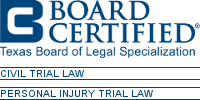Presented to Greater Houston Anesthesiology, P. A., November 13, 1999
Liability:
1. General Statement of Liability:
Bowles v. Bourdon, 148 Tex. 1, 219 S.W.2d 779 (1949)
Facts: Patient, a minor, broke his arm, which was set and casted by Dr. X. The patient’s father, on behalf of his son, sued Dr. X, alleging the cast was too tightly bound, resulting in permanent arm paralysis. The trial court directed a verdict in favor of the physician, which was then appealed. Judgment affirmed.
Critical Holding: No patient has a cause of action for malpractice against his physician unless he proves, through a doctor of the same school of practice, both that: (a) the diagnosis or treatment was negligent; and (b) the negligence was a proximate cause of the patient’s injuries.
2. No Guarantee of Cure:
Hood v. Phillips, 544 S.W.2d 160 (Tex. 1976)
Facts: Patient suffered from emphysema, and sought treatment from Dr. X. Dr. X removed one of the patient’s carotid bodies from his neck, in an attempt to: “improve the airflow to the lungs by lessening the spasm of the involuntary muscles in the bronchial tubes.” Dr. X admitted that the procedure was not generally accepted in the medical community, but testified he had done it between 1200 – 1500 times with 85% of the patients experiencing improvement. The trial court only asked the jury whether Dr. X was guilty of gross negligence, which was answered in the negative. The case was remanded for a new trial on ordinary negligence and informed consent.
Critical Holdings:
A. The court upheld that no physician can be held liable as a guarantor that his proposed treatment will be successful.
B. The court upheld as the standard that a physician will be held liable only if he failed to act as a reasonably prudent physician would have under the same or similar circumstances.
C. The court rejected a standard that would absolve a physician if he conforms to what a “respectable minority” of physicians would do.
3. “Medical Judgment Rule”:
Burks v. Meredith, 546 S.W.2d 366 (Tex. Civ. App. – Waco 1976, writ ref’d n.r.e.)
Facts:The patient was shot in the stomach and was taken to Dumas Hospital, where he was seen by Dr. X, a general practitioner who performed some surgery. Because Dr. X had experience with gunshot wounds and with abdominal surgery, he did not feel it necessary to call in a general surgeon. Dr. X proceeded to perform an exploratory laparatomy. During the procedure, Dr. X repaired a colonic perforation he found from the bullet entry wound. The patient was placed on antibiotics, but later developed an obstruction at the surgery site, secondary to surgical adhesions, and was taken back to surgery by Dr. X. During the second surgery, Dr. X reopened the colon and then called in a general surgeon. When freeing the adhesion, the colon tore, causing an extravasation of fecal content. The patient later died of peritonitis. His survivors sued Dr. X, principally under a theory that he should have called in a general surgeon for both procedures. Jury found for Dr. X, which was affirmed on appeal.
Critical Holding:Affirmed. At best, the plaintiffs proved that Dr. X erred in his judgment as to whether he would be able to handle the surgeries. There was no testimony presented that a reasonably prudent general practitioner, with experience in this area, would not have attempted either surgery. A physician ordinarily cannot be held liable for errors of judgment.
4. Res Ipsa Loquitur:
Haddock v. Arnspiger, 793 S.W.2d 948 (Tex. 1990)
Facts:The patient’s colon was perforated during a colonoscopy by Dr. X. The patient pleaded simple negligence and under the doctrine of res ipsa loquitur. The trial court refused to submit the res ipsa loquitur issue, and the jury found in favor of Dr. X on the negligence claim. The patient appealed, and the judgment was affirmed.
Critical Holding:The doctrine of res ipsa loquitur means “the thing speaks for itself.” It allows a plaintiff to prevail on a negligence theory, without any particular proof as to the defendant’s specific negligent conduct. It arises only when: (a) the event would not ordinarily occur in the absence of negligence; and (b) the instrumentality which caused the incident was under the exclusive control of the defendant immediately prior to the injury. However, when article 4590i was passed, in 1977, it limited application of the doctrine in medical malpractice suits only to those instances in which it had previously been applied. Accordingly, the doctrine is only potentially applicable to instances which would be within the knowledge of ordinary laypersons, such as surgery on the wrong part of the body, leaving a foreign object, and sometimes from injury resulting from the use of a mechanical object, such as burning from an x-ray machine. However, where the type of mechanical instrument being used is not within the ordinary knowledge of laypersons, such as the use of a colonoscope, the doctrine will not be applied.
5. DTPA and Doctors:
Sorokolit v. Rhodes, 889 S.W.2d 239 (Tex. 1994)
Facts:The patient went to Dr. X for breast augmentation surgery. Dr. X allegedly showed Ms. Patient and her husband a book with pictures of nude models and told them to pick the breasts they liked. When they did, Dr. X allegedly guaranteed the patient that her breasts would look just like the picture after surgery, and they did not. Mr. and Ms. Patient sued Dr. X under the Texas Deceptive Trade Practices – Consumer Protection Act, contending that he had warranted a particular result. The case was dismissed and the plaintiffs appealed. The judgment was reversed for trial.
Critical Holding:Article 4590i specifically excludes liability for physicians for claims arising in negligence under the DTPA. However, the claim in issue here was not a claim based in negligence, but rather one based on an express warranty. Accordingly, the suit could be brought under the DTPA against the physician.
6. Liability for CRNA Negligence:
Owens v. Litton, No. A14-90-0442-CV, 1991 Tex. App. LEXIS 2656 (Tex. App. – Houston [14th Dist.] 1991)
Facts:Patient underwent surgery at St. Mary’s Hospital in Galveston. Anesthesia was administered by a CRNA (hospital employee), who was supervised by anesthesiologist Dr. X. Dr. Y was the Chief of Anesthesia at St. Mary’s, and the president of the group which had the anesthesia contract at St. Mary’s. Patient suffered a cardiac arrest and subsequently died. His survivors sued and settled with everyone but Dr. Y. The case against Dr. Y was dismissed on summary judgment and the plaintiffs appealed. The case was reversed for trial.
Critical Holding:Whether a supervisor can be held liable for the negligence of someone he is supervising is generally determined by whether the supervisor controlled the details of the employee’s work or had the right to control same. In this case, the contract with Dr. Y’s group gave Dr. Y the right to control exactly how the CRNA carried out his duties. Accordingly, there was a fact issue presented as to whether Dr. Y had the right to control the CRNA’s work and thus could be held liable for his negligence.
Defenses:
1. Unavoidable Accident (Complication):
Wisenbarger v. Gonzales Warm Springs Rehabilitation Hosp., Inc., 789 S.W.2d 688 (Tex. App. – Corpus Christi 1990, writ denied)
Facts:The patient, at age 74, was thrown from his motorcycle and rendered a paraplegic. Post-surgery, he was transferred to Gonzales Warm Springs Rehabilitation Hospital for recuperative care and paraplegic training. While there, a previously existing decubitus ulcer deteriorated, ultimately exposing his spinal cord and requiring a secondary closure. The patient sued the facility for negligence. The facility plead that the deterioration of the ulcer was an “unavoidable accident,” a defensive theory historically allowed when there is evidence an event, like an automobile accident, was caused by some force beyond the control of either the plaintiff or the defendant, such as ice on the roadway. In this case, the facility contended that the deterioration of the decubitus ulcer was caused by the patient’s advanced age, his paraplegic condition, and the nature and location of the original injury. The trial court submitted the negligence/proximate cause issue to the jury with the following instruction: “An occurrence may be an unavoidable accident, that is, an event not proximately caused by the negligence of any party to it.” The jury found in favor of the facility, and the patient appealed. The judgment was affirmed.
Critical Holding:If there is evidence that the injury was caused by some condition of nature, such as infection, etc., which was not related to the defendant’s conduct, the “unavoidable accident” defense can apply in a medical malpractice case. It is somewhat confusing as worded, and probably should be referred to as an “unavoidable complication,” rather than an “unavoidable accident.”
2. Limitations:
Nelson v. Krusen, 678 S.W.2d 918 (Tex. 1984)
Facts:Mr. and Ms. Patient gave birth to a child with Duchenne muscular dystrophy. Several years later, Ms. Patient became pregnant again. Their Ob/Gyn, Dr. X, advised the Nelsons that they were no more likely to give birth to another child with Duchenne muscular dystrophy than a family without their prior history. They proceeded with the delivery. Three years after birth, the child developed notable neurologic problems and was diagnosed with Duchenne muscular dystrophy. The Nelsons sued Dr. X for negligence. The case was dismissed because it was not brought within two years of the medical treatment in issue. Reversed for trial.
Critical Holding:The “absolute” two year limitation period of article 4590i (actually a materially identical prior statute), is unconstitutional as applied to the extent it cuts off a patient’s cause of action before the plaintiff could reasonably have discovered same. The Patients could not possibly have discovered their son’s Duchenne muscular dystrophy within two years of Dr. X’s alleged negligence, and therefore the limitations period is unconstitutional as applied to their claim.
3. Limitations as to Minors’ Claims:
Weiner v. Wasson, 900 S.W.2d 316 (Tex. 1995)
Facts:When the minor patient was 15 years old, Dr. X operated on his right leg, inserting metal pins in the femur. Later, it was determined that one of the pins was protruding into the right hip joint. The patient turned 18 on December 16, 1999, and underwent a total hip replacement a few years later. Eighteen months after he turned 18, the patient sued Dr. X. The case was dismissed on the basis of the limitations period of article 4590i, which stated that minors’ claims must be filed within two years of the treatment in issue, excepting only that minors under the age of 12 must file by their 14th birthday. Case dismissed on summary judgment – remanded for trial by the Supreme Court of Texas.
Critical Holding:To the extent article 4590i requires a minor, who suffers under a legal disability, to file a claim before he attains the age of majority, the statute is an unconstitutional deprivation of the minor’s access to the courts. Accordingly, the minor has two years from his 18th birthday to file suit.
4. Patient Contributory Negligence:
Elbaor v. Smith, 845 S.W.2d 240 (Tex. 1992)
Facts:The patient’s left ankle was very seriously injured in an automobile accident. After initial surgical treatment, she was transferred to the care of Dr. X, at Arlington Community Hospital [ACH]. Ultimately, after severe infection was encountered, the patient’s ankle had to be fused, resulting in permanent disability. There was evidence that the patient’s ankle was not infected when she arrived at ACH. There was also evidence that the patient refused to take prophylactic antibiotics at ACH, and that the antibiotics probably would have prevented the infection. The jury found in favor of the plaintiff. However, the trial court refused to submit the issue of the patient’s contributory negligence, and Dr. X appealed. Reversed for retrial.
Critical Holding:When there is expert evidence that the plaintiff’s own conduct fell below the standard of a reasonably prudent person under the same or similar circumstances, and that conduct contributed to the injury in issue, it is error to refuse to submit the plaintiff’s contributory negligence. However, note the distinction in Sendejar, below, and note that the trial court also refused to submit Ms. Smith’s contributory negligence in smoking. The Texas Supreme Court declined to address whether this pre-medical treatment conduct by the patient could constitute contributory negligence.
Sendejar v. Alice Physicians & Surgeons Hosp., Inc., 555 S.W.2d 879 (Tex. Civ. App. – Tyler 1977, writ ref’d n.r.e.)
Facts:One Saturday evening, the patient, Jr., a 20 year old male, ran his vehicle off the road at a high rate of speed after becoming drunk. He was taken by ambulance to the hospital. Because of his intoxication, the Emergency Department physician, Dr. X, could only perform a limited examination. Plain film x-rays of the spine were negative, and the patient had no complaints of back pain. He was admitted under the service of his family physician, Dr. Y. Dr. Y did not see the patient over the weekend. On Sunday evening, the nurses noted the patient was paraplegic. He was later transferred and determined to be a permanent paraplegic. The jury found in favor of the defendants, and also found that the patient’s negligence in driving while intoxicated was the sole cause of his paraplegia. The plaintiff appealed, contending that his pre-treatment conduct could not be contributory negligence to the medical malpractice cause of action as a matter of law. Judgment affirmed, but only because the finding of contributory negligence was moot, in light of the findings in the defendants’ favor as to their negligence.
Critical Holding:In order for the patient’s conduct to be contributory negligence, “it must have been an active and efficient contributing cause of the injury; it must have been simultaneous and co-operating with the alleged fault of the defendant, must have entered into the creation of the cause of action, and must have been an element in the transaction which constituted it.” The patient’s negligence in causing the accident which brought him to the hospital cannot be determined with the defendants’ medical negligence, perhaps to bar the plaintiff’s recovery. This holding is consistent with the common law “plaintiff as an eggshell” theory; i.e., that a negligent tortfeasor takes his victim as he finds him.
Query: The Sendejar case preceded modern Texas comparative responsibility law, in which any conduct on the part of the plaintiff, which violates any standard and that contributes in any way to the injury in issue, must be submitted to the jury. Suppose a patient expires of intra-operative respiratory problems secondary to years of voluntary smoking, but the family sues the anesthesiologist for failure to properly resuscitate. Should the anesthesiologist be able to plead and prove that the decedent’s own negligence was a cause of his death?
Expert Testimony:
1. Standards for Expert Testimony:
Broders v. Heise, 924 S.W.2d 148 (Tex. 1996)
Facts:The patient had been drinking and was brutally beaten by an unknown assailant. She was found unconscious on the sidewalk and transported to the hospital. At the hospital, there was no evidence of significant head trauma. A head CT was negative. The patient was released in relatively good condition, about 16 hours after arrival. Around five hours later, she was returned to the hospital. A repeat head CT, interpreted by a neurosurgeon, revealed fractures, with both bleeding and swelling of the brain. Mannitol was administered but the patient quickly deteriorated and expired. The neurosurgeon testified for the defense that the patient had suffered a diffuse mechanical disruption to the cerebral cortex, the cerebellum, and the brain stem, which resulted in general swelling of the brain tissues. The condition was untreatable and inoperable, and any efforts to control the swelling medically would not likely have been successful. The plaintiffs offered the testimony of an Emergency Department physician, who attempted to testify that earlier treatment would likely have saved the patient’s life. The testimony was refused by the trial court, and the jury returned a verdict in the physician’s favor. The plaintiffs appealed, but the judgment was affirmed.
Critical Holding:The fact that a witness is a licensed medical doctor does not give him the right to offer opinions in all medical subject areas. An emergency room physician conceivably might be able to testify in this area, but the plaintiffs would first have to establish that he was sufficiently qualified in that particular field to be able to offer the testimony.
Ponder v. Texarkana Memorial Hospital, Inc., 840 S.W.2d 476 (Tex. App. – Houston [14th Dist.] 1991, writ denied)
Facts:Patient was born at Texarkana Memorial Hospital, to a gestationally-diabetic mother. He was later determined to have brain damage, and the plaintiffs contended it was caused by both low calcium and low blood sugar levels during the first 48 hours of life, as well as dilantin toxicity. The plaintiffs offered the testimony of Dr. Z, who had masters degrees in both physiology and biology. Dr. Z had a doctorate in neuroscience, and had taught on the faculty at Baylor College of Medicine in research, neuroscience, neurology, and sensory neurophysiology. Dr. Z was offered to testify as to the cause of Steven’s brain damage, however, the trial court excluded the testimony on the basis that Dr. Z was not a licensed medical doctor. Partial directed verdicts were granted, and the jury returned verdicts in the defendants’ favor on the remaining issues. The plaintiffs appealed, and the case was reversed for retrial.
Critical Holding:Dr. Z was properly qualified to render opinions on causation of brain injuries. He taught neurophysiology to medical students, and it is implausible to suggest he is unqualified to address the issues for a lay jury. It is not necessary that he be licensed to practice medicine.
2. Physician Can Set Own (Negative) Standards:
Allen v. Roark, 625 S.W.2d 411 (Tex. App. – Fort Worth 1981), aff’d in part and rev’d in part, 633 S.W.2d 804 (Tex. 1982)
Facts:The patient was delivered by forceps in a frank breech presentation by Dr. X and Dr. Y. The child’s skull was fractured by the forceps delivery. The parents sued for the child’s pain and suffering. At trial, the plaintiffs presented no expert testimony. However, Dr. X testified that, if a fracture was presumed to exist as a result of the procedure, the standard of care would require that the parents be advised so that the child’s skull could be evaluated. The juCir.ound in favor of the plaintiffs.
Critical Holding:Dr. X’s testimony was sufficient to create a fact issue as to his negligence. Independent expert testimony was unnecessary.
Damages:
1. Constitutionality of Article 4590i Damage Caps:
Lucas v. United States, 757 S.W.2d 687 (Tex. 1988)
Facts:The patient, fourteen months old, developed a swollen neck and fever after a family outing. He was taken to the hospital, where the ED physician determined the child had a cyst in his thyroglossal duct, and ordered an injection of 600,000 units of antibiotics. Unfortunately, the nurse apparently administered the antibiotic directly into the child’s artery, resulting in permanent paraplegia. The court found in favor of the plaintiffs, and awarded damages of several million dollars. The defendants appealed, contending that the liability caps of article 4590i prevented them from being held liable in excess of $500,000, adjusted by changes in the Consumer Price Index since 1977.
Critical Holding:The damage caps under article 4590i are in violation of the “Open Courts” provision of the Texas Constitution. Prior to passage of article 4590i, plaintiffs had a well-recognized common law cause of action for injuries sustained as a result of physicians’ negligence. For a statute that would purport to cut off or restrict such a common law right to survive constitutional scrutiny, the act of the legislature in doing so must not be unreasonable or arbitrary. In other words, there must be shown somewhere in the legislative history that there is a valid correlation between the goal sought to be obtained by the statute and the restriction provided. In article 4590i’s legislative history, there is no evidence that limiting damages in this fashion would have an effect on the availability of, or the rates charged for, medical malpractice insurance. Thus, the statute was both unreasonable and arbitrary, and accordingly must be stricken under the Texas Constitution. “We understand the legislature’s concern in attempting to resolve the health care problems it perceived during the middle of the 1970’s. Nevertheless, we agree with the statement by the Supreme Court of New Hampshire: ‘It is simply unfair and unreasonable to impose the burden of supporting the medical care industry solely upon those persons who are most severely injured and therefore most in need of compensation.”
Rose v. Doctors Hosp., 801 S.W.2d 841 (Tex. 1990)
Facts:The patient died at Doctors Hospital. His wife and parents brought a wrongful death suit against the hospital, alleging that Rose died as a result of the negligent administration of a fatal dose of morphine. The jury awarded several million dollars to the plaintiffs. The hospital appealed, contending that the judgment violated the damage cap of article 4590i. The judgment was reduced to the cap and otherwise affirmed.
Critical Holding:This case is different from Lucas. In the Lucas case, it was the injured plaintiff who was bringing a cause of action for his own injuries under the common law. However, under the common law, once the patient expires, all causes of action expire with him. Under current statutory law, the survivors can now continue with the decedent’s cause of action in this circumstance, and can also bring their own cause of action for wrongful death. However, these are statutory causes of action. The Texas Constitution’s Open Courts provision only affects well-recognized common law causes of action. Since the survival and wrongful death actions are purely creatures of statute, the legislature is perfectly free to amend the remedies afforded under same by further statutory enactment.
Unanswered Questions: Under Rose, two defendants were found liable, with joint and several liability. Although not reflected in the opinion, it appears from further research that a joint and several judgment was entered against both defendants for the equivalent of two caps. This would appear to violate the cap, which provides that: “In an action on a health care liability claim where final judgment is rendered against a physician or health care provider, the limit of civil liability for damages of the physician or health care provider shall be limited to an amount not to exceed $500,000.00.”
Also unaddressed in the opinion is whether prejudgment interest or punitive damages can be added on to the cap. Again, though, further research indicates that the judgments in Rose included prejudgment interest, although that would appear to violate the cap language as well. This question should be answered by the Texas Supreme Court in a case scheduled for argument on November 16, 1999, styled: Horizon /CMS Healthcare Corp. v. Auld, 985 S.W.2d 216 (Tex. App. – Fort Worth 1999, writ granted).
Counter-Claims:
Martin v. Trevino, 578 S.W.2d 763 (Tex. Civ. App. – Corpus Christi 1978, writ ref’d n.r.e.)
Facts:The patient, acting through her lawyer, attorney Y, filed suit against the patient’s physician, Dr. X, alleging malpractice. Dr. X filed a counter-claim against the patient and attorney Y, contending the suit was frivolous and the plaintiff and her lawyer ought to be held liable for attorneys’ fees and damages. The patient later dismissed her claim against Dr. X voluntarily. Dr. X amended his counter-suit to raise causes of action for negligence, malicious prosecution, abuse of process, prima facie tort, and breach of the Texas Code of Professional Responsibility as to the lawyers. The patient and attorney Y moved for summary judgment, which was granted. Dr. X appealed, but the judgment was affirmed.
Critical Holding:Texas law does not support a counter-claim against the plaintiff or her attorneys under any theory asserted. The sole remedies for frivolous suits must be found in other applicable statutes or rules, not under the common law.
Detenbeck v. Koester, 886 S.W.2d 477 (Tex. App. – Houston [1st Dist.] 1994, no writ)
Facts:Patient, acting through her attorney, filed suit for malpractice against her physician, Dr. X. Dr. X contended that patient was motivated to file the suit solely because of mounting medical bills, and solely to attempt to extort a settlement from Dr. X’s liability insurance carrier. Discovery somehow revealed that patient’s first lawyer had the case reviewed by an orthopedic surgeon, who concluded there was no liability. That lawyer withdrew and attorney Y took over the case, filing suit just before limitations expired. The case languished for seven years, at which time attorney Y allegedly started threatening to try the case, solely to coerce a settlement. Dr. X resisted. Two years later, the patient and attorney Y elected to dismiss the case voluntarily with prejudice. Dr. X then brought suit against the patient and attorney Y, claiming abuse of process. The case was dismissed, and the judgment was affirmed.
Critical Holding:The holding in Martin v. Trevino continues to be good law. Even if Dr. X can prove that the case was filed without probable cause and with malicious intent of coercing a settlement, no cause of action is created for abuse of process. The physician’s sole means of recourse remains under the Texas Civil Practices and Remedies Code and the Texas Rules of Civil Procedure.








